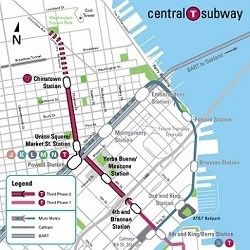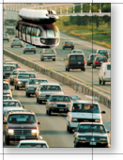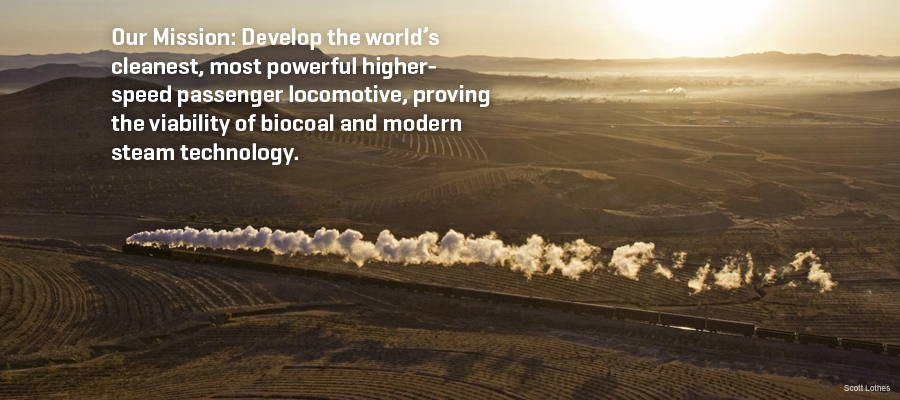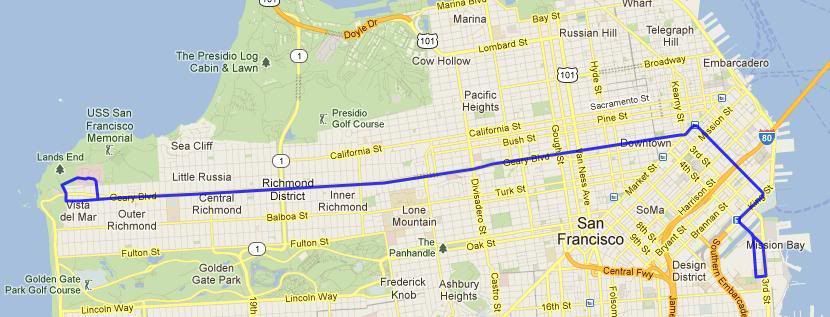Burning the Midnight Oil for Living Energy Independence
 This week’s Sunday Train is a trio of shorter topics. The first is a research development project to develop a modern steam train to run on biocoal. The target is a sustainable steam train that, as a headline grabber, will attempt to run at 130mph and break the world steam train speed record. There’s much to like about this research development project … but I am going to argue that biocoal to operate trains is not it.
This week’s Sunday Train is a trio of shorter topics. The first is a research development project to develop a modern steam train to run on biocoal. The target is a sustainable steam train that, as a headline grabber, will attempt to run at 130mph and break the world steam train speed record. There’s much to like about this research development project … but I am going to argue that biocoal to operate trains is not it.
 Second, SF’s MUNI transport agency is one of the ten agencies slated to split $760m in Prop1a(2008) bond funds improvements to systems interconnecting with the planned High Speed Rail system. The balance of the $950m goes to the three existing Amtrak California intercity rail services, the Capitol Corridor, the San Joaquin, and the Surfliner.
Second, SF’s MUNI transport agency is one of the ten agencies slated to split $760m in Prop1a(2008) bond funds improvements to systems interconnecting with the planned High Speed Rail system. The balance of the $950m goes to the three existing Amtrak California intercity rail services, the Capitol Corridor, the San Joaquin, and the Surfliner.
Odd thing is, the proposal that SF MUNI is setting forward doesn’t actually connect to the proposed HSR system? What’s up with that, after the break.
 And third, a speculative look at an alternative technology that SF MUNI might deploy that money on, that actually would connect with the HSR system at the Transbay Terminal, as well as connecting to BART, the MUNI light rail network, the existing (and proposed alternative) Caltrain terminus at 4th and King, and provide express transit service along Geary Blvd.
And third, a speculative look at an alternative technology that SF MUNI might deploy that money on, that actually would connect with the HSR system at the Transbay Terminal, as well as connecting to BART, the MUNI light rail network, the existing (and proposed alternative) Caltrain terminus at 4th and King, and provide express transit service along Geary Blvd.
So instead of the traditional long trip, Sunday Train for Memorial Day Weekend has three short exursions. Join us for one, two, or all three, after the break.
Say What? A Sustainable Steam Train?
The story I have here from Smart Planet says:
This week, the Coalition, a project of the University of Minnesota’s Institute on Environment, teamed up with Sustainable Rail International, a non-profit advocacy group, to announce the launch of an initiative to build the world’s fastest biofuel-powered steam locomotive.
If successful, the prototype won’t just be carbon-neutral; it will also eclipse the current steam locomotive world record by traveling at 130 m.p.h.: providing a compelling alternative to diesel-electric trains used today.
 The first thing that popped into my mind was, “wait a minute, what’s the likelihood they swap out the biocoal for mineral coal?”. But on reflection, the summary description of biocoal at the project site, there may be hurdles in the way of that switch:
The first thing that popped into my mind was, “wait a minute, what’s the likelihood they swap out the biocoal for mineral coal?”. But on reflection, the summary description of biocoal at the project site, there may be hurdles in the way of that switch:
Imagine a fuel with the same energy, density and material handling properties of coal, without a carbon footprint, heavy metal or sulfur. The University of Minnesota’s Natural Resources Research Institute (NRRI), a leader in the efficient processing of cellulosic biomaterial into carbon neutral biocoal, has engineered such a fuel.
The hurdle here is not the carbon footprint, its the sulfur and heavy metals in mineral coal. A biocoal powered steam train would benefit from the absence of large amounts of sulfur and heavy metals in that it would not have to scrub those from the exhaust. It could well be that the weight saving would justify the reliance on biocoal rather than mineral coal.
A Sustainable Steam Train in the context of the Steel Interstate project
Now, regular readers of the Sunday Train will know that I advocate Steel Interstates, in the form of a nationwide project for the electrification of mainline rail corridors, establishment of 100mph Rapid Rail train paths, and utilization of rail corridors to establish a national network of Electricity Superhighways to interconnect renewable energy surplus regions, for a more stable total supply, and connect those surplus regions to potential consumers, to allow us to take full advantage of our highest quality renewable energy resources.
Part of the economics of electrification is the idea that roughly 80% of rail traffic will be using roughly 20% of the track, with the electrification focusing on corridors where it will deliver the most bang for the buck. However, this leaves the other (roughly) 20% of traffic that is not running under the wires, over the (roughly) 80% of the network that is not electrified. So technologies to power a train by carbon-neutral fuel complement the core Steel Interstate system designed to run on sustainable electricity. Even better if that technology generates electric power to drive an electric drive train, in which case the fueled locomotives can switch to running on electric power once they join the electrified Steel Interstates.
The technology here would represent one approach to carbon-neutral fuel for those trains. The carbon neutrality requires a sustainable, renewable source of biomass for the biocoal, so as much biomass is produced in a given year as is consumed to produce biocoal. In that case ~ and only in that case ~ the biomass production is removed as much carbon dioxide from the atmosphere each year as consumption of the biocoal is returning.
Should Modern Steam Locomotives be Powered with BioCoal
I do not believe that powering sustainable locomotives is the best use of biocoal. Humans already consume a scarily large fraction of total biomass production on the planet. The balance of biomass production is the engine for the ecosystems that are the planetary life support system that we take for granted.
So while I am a supporter of the development of biocoal as a sustainable energy source (as I have blogged about before), I do not view locomotive fuel as the most effective way for biocoal to contribute to a carbon-neutral economy.
Unlike some advocates of the use of biomass energy, I view sustainable biomass energy as something that can only contribute a fraction of our current energy consumption. This is a contrast to windpower, where we have ample windpower energy resources for several multiple of our current total energy production, so that the constraints on windpower share involves the volatility of supply, and not the total supply available.
I argues that any renewable energy source that can offer a definite budget should be used in the role that takes best advantage of its particular strengths. And the particular strength of biocoal is its stability in long term storage. For that reason, I advocate focusing biocoal supplies on providing scheduled firming back-up power that is a part of an energy portfolio that contains more than 30% wind and solar power in the electricity grid. That long term stability in storage is wasted on a fueled locomotive, which is fueled up with high frequency.
Why the Sustainable Steam Train is a Great Development Project
However, I strongly support this project. This is a development and demonstration project that includes more than just the use of biocoal to power a steam train. As CSR explains, it also includes the development of 21st century steam engines for locomotive power:
CSR will take a locomotive from 1937 and turn it into the world’s first modern steam engine run on biofuel. The CSR team draws on extensive expertise in modern, thermodynamically-efficient and low maintenance steam locomotives, and the efficiency and speed that will result from this new technology will exceed all expectations of what a steam locomotive can be.
If the project succeeds in breaking the steam train speed record, it will be a headline grabber. And that headline grabbing will be useful simply in changing expectations about what a 21st Century Steam Locomotive can be.
After all, biocoal may be one of the most energy efficient means of converting biomass into a high energy density, stable fuel source ~ but a steam engine is not restricted to operating with biocoal. In particular, one means of taking advantage of abundant “use it or lose it” energy sources like wind and solar energy is to convert it to a stored fuel. One of the potential fuels advanced by a committed group of advocates has been Ammonia ~ NH3, a far easier to transport, store, and use hydrogen fuel than H2. While NH3 requires a primer fuel to serve as the fuel for a diesel engine, an efficient external combustion engine could well be a more effective means of using Ammonia fuel in a train locomotive.
And for biocoal, while we have substantial thermal coal power plant generating capacity that are obsolete in their role of burning mineral coal for baseload power ~ they are very large scale units. Development work on the burning of biocoal for efficient small scale power generation, as in generating the power to drive locomotive electrical engines, may well be useful in allowing for much finer tuning of the amount of firming power scheduled to be placed onto the grid. So even if the most appropriate use of biocoal is as a firming power supply, this development project could well bear fruit for that task.
So, SF MUNI, you want to connect to the HSR … by bypassing its station?
The next excursion I am taking in the Memorial Weekend Sunday Train is into some side alleyways of the California HSR project.
As part of the process of approving $9b in bonds for the HSR program, one of the amendments made by the State Legislature that changed “Prop1” into “Prop1a” was the addition of $950m in bonds for intercity and local rail systems connecting to the HSR system. The allocation was in two parts. The intercity party was $190m allocated to the three Amtrak California corridors: the Surfliner, the San Jaoquin, and the Capitol Corridor. The local rail party was $760m allocated to ten local and regional rail operating authorities, with a formula based equally on shares of state rail ridership, shares of state rail vehicle miles, and shares of state passenger track miles. The resulting allocation is roughly:
- 33% BART
- 16% SoCal Metrolink
- 15% LACouny MTA
- 8% SF MUNI
- 7% San Diego MTS
- 5% Caltrain
- 4% Sacramento RTD
- 3% Santa Clara VTA
- 2% North Coast TD
- 2% ACE
 These funds are supposed to provide for interconnection with the HSR system. So imagine my surprise when I read at the California HSR blog that SF Muni Seeks Prop 1A Funds for Central Subway. As you can see on the map of the Central Subway at the right (from the official site), the Central Subway takes one of the light rail corridors in the city and re-routes it to run down 4th Street, into a deep bore subway tunnel, toward a Market Street station with a connection to Powell Street BART, and then up to Chinatown. Later extensions could
These funds are supposed to provide for interconnection with the HSR system. So imagine my surprise when I read at the California HSR blog that SF Muni Seeks Prop 1A Funds for Central Subway. As you can see on the map of the Central Subway at the right (from the official site), the Central Subway takes one of the light rail corridors in the city and re-routes it to run down 4th Street, into a deep bore subway tunnel, toward a Market Street station with a connection to Powell Street BART, and then up to Chinatown. Later extensions could
They are already building this thing, so its a bit late to modify the alignment, but this funding request brings a spotlight on one minor point: it doesn’t connect with the San Francisco HSR station at the Transbay Terminal!
Two packages of requests to release this interconnection bond funding have been vetoed by two successive Governors because too many of the projects have little to no connection with the core criteria of connecting with the planned HSR system.
Some of the project requests do fit the criteria. The LA County MTA request is for their “Central Subway”, which unlike the SF Muni proposal connects to LA Union Station, a designated HSR station. While Sacramento doesn’t have a designated station, they want to use the money for upgrading their Amtrak California station into an Intermodal station, and it seems likely that the HSR would either use that as its terminal or connect directly to it. But some requests … well, are like San Francisco MUNI’s request, something that they are building anyway, and would like some extra money for, thank you very much.
The most charitable reading of this request is that if SF MUNI doesn’t ask, then when they go to borrow money to finish the Central Subway, they will get the objection, “but you could build this with Prop1a money!”. So they are going to ask until they get a firm enough rejection that they can say, “well, we tried”.
An Aerobus for Geary Blvd?
Five or six years ago, I talked about the Aerobus technology, an elevated light rail system with a very cost-efficient system of laying track on suspension cable, and suspending the passenger cabin underneath the drive module. It is a technology that has won a variety of technology competitions, but the projects it was competing for, in the funding environment of the 90’s, never came to fruition. It was to be installed in Weihai, China, but its possible that the project was run-over by the global financial crisis.
However, San Francisco is the ideal city for this type of transport. It’s ideal role is as a separated guideway, “Express Stop” system in an urban environment. Its top speed is in the range of 35mph, so its not an outer-suburban rail system, but rather an urban rail system in an environment where an at-grade alignment is difficulty to provide while conventional subways and elevated rail are expensive. Unlike Monorail, supports can be as much as a quarter mile apart, and the light rail track on suspension cable system is substantially lighter and cheaper than the rubber tires on a cement guideway system of a monorail.
All of this came back to mind when I looked at the map for the SF 4th Street Subway. In the middle of the last decade, the Aerobus venture company was advertising system costs of $15m to $30m per mile. If we assume cost inflation since then, it seems like $30m would be more like the midpoint estimate. SF Muni is getting about $60m, so with that, they could get about 2 miles of Aerobus system.
When I looked at an Aerobus system in San Francisco, the first thing that came to mind is Geary Blvd. This cuts right across the Peninsula, and ends on Market Street. Up Market Street a block is the Montgomery St BART station, and then down 2nd Street is the southern end of the TBT terminal. If you keep going down 2nd Street, you get to the Ballpark. Turn down King Street, you get to Caltrain 4th and King, which under current plans will remain as the terminus for Caltrain Express trains, and then a short distance south is the UCSF Mission Bay campus. North of the west end of Geary Blvd is the SF VA Medical Center. So that’s how I laid out the system:

Now, 2 miles gets you from the UCSF Mission Bay Campus to about the junction of Geary and Market Street, so under this approach, that would be Stage 1. A substantial amount of the benefit of a suspended light rail system is in this first segment. It crosses from Mission Bay to King without requiring an addition to the bridge. It easily crosses the street to serve the 4th and King Caltrain station on the west side of King and the ballpark on the east side of King. It crosses over the Expressway by just going over it. It only requires one support pylon between the Expressway and Market Street. And, of course, it operates entirely unimpeded by traffic, by the simple expedient of going where the traffic isn’t.
Saying that it could be extended down Geary Blvd is not to say that it should. However, there is another aspect of the Aerobus that would see it extending a good way along Geary Blvd. Since the Aerobus has the ability to have a quarter mile of guideway between support points, and the bridge itself provides the elevated support, the addition of Aerobus guideway to the underside of a bridge would be less expensive than free-standing Aerobus guideway. Which means that extending the Aerobus route north to the Embarcadero would allow it to jump over to the Bay Bridge, which would allow it to connect to the San Joaquin and Capitol Corridor. It could even extend to the Oakland Airport.
Now, will MUNI decide to pursue an Aerobus system? Any difference from 100% odds of “No” would be rounding error. Aerobus itself seems to be in mothballs at present, so it can’t press the case. MUNI itself is focused on finishing the Central Subway, and even if there is a possible initial source of funding, with no local political pressure to pursue it, and with their rail system build around an entirely different type of rail technology, there will be no internal organizational pressure to pursue it, and plenty of internal organizational resistance.
The only Bay Area organization that really would have the means to pursue it would be BART: that is, if BART decides that they are the ones that do all-grade separated systems, so that the system is “AeroBART”. While all of the same checks against it apply, BART’s Prop1a allocation is about $250m, so they could construct Stage 1 from UCSF Mission Bay to Market & Geary on less than a third of their Prop1a(2008) allotment.
Coming Back Home From Our Excursions
Well, I hope that you had an interesting Memorial Day excursion, whichever of and however many of the three excursions you chose to take. Remember that the Sunday Train is open for discussion of any sustainable transport topic that you are to raise, in addition to discussing the topic of today’s essay.
Since it is Memorial Day, the performance from the headliners at Burning The Midnight Oil can be nothing other than “Forgotten Years”.
Midnight Oil ~ Forgotten Years
Few of the sins of the father, are visited upon the son
Hearts have been hard, our hands have been clenched in a fist too long
Our sons will never be soldiers, our daughters will never need guns
These are the years between
These are the years that were hard fought and won
Contracts torn at the edges, old signatures stained with tears
Seasons of war and peace, these should not be forgotten years
Still it aches like tetanus, it reeks of politics
How many dreams remain? This is a feeling too strong to containThe hardest years, the darkest years, the roarin’ yrs, the fallen years
These should not be forgotten years
The hardest years, the wildest years, the desperate and divided years
We will remember, these should not be forgotten years

1 comments
Author